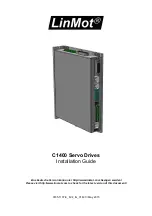
27
Digitax SF
Instruction Man
ual
Tuning
7
7. Tuning
3.
Tuning Parameters
3. Tuning Parameters
Function
With this parameter, a set of the tuning parameters can be set all at once�
(*1)
Increasing the value of this parameter will improve the command response, position
deviation during motion, settling time, and control rigidity�
Parameter Set
113�0
(Position Control Mode)
Control level
114�0
Control Gain 1
115�0
Control Gain 2
116�0
Integral gain
119�0
Torque command filter: Low-pass filter time constant
(*2)
162�0
129�0
(Velocity Control Mode)
Control level
130�0
Control Gain 1
131�0
Integral gain
133�0
Torque command filter: Low-pass filter time constant
(*2)
162�0
Remark
Too high a setting will cause noise�
When increasing the value, check the resulting operation to avoid oscillation or vibration�
Tuning Tip
• Set the value to 5 first to fix the inertia ratio�
• Gradually increase the setting value while watching the motion�
If noise occurs, use a notch filter or decrease the low-pass filter setting�
Page 42 Torque Command Filter: Notch filter
Page 43 Torque Command Low-Pass Filter
*2) This is when Low-pass filter auto Setting (160�2) = 1 (auto setting ON)
Control gain set settings
Command
Responsiveness
Rigidity
Settling Time
Noise
5
slow
low
long
unlikely
10
↑
↓
↑
↓
↑
↓
↑
↓
15
(Default)
20
30
quick
high
short
likely
Under the Auto Tuning tab, tick the detail setup box, and then select from 1-46 one by one�
*1) In the
Digitax SF Connect
parameters grouped in the control gain set are highlighted in green�
Control Gain Set
Summary of Contents for Control Techniques Digitax-SF DA21223
Page 6: ...6 MEMO Digitax SF Instruction Manual ...
Page 23: ...17 MEMO Digitax SF Instruction Manual 1 Before Use 2 Overview ...
Page 283: ...48 MEMO Digitax SF Instruction Manual 6 Operation 5 Position Control Mode ...
Page 329: ...46 MEMO Digitax SF Instruction Manual 7 Tuning ...
Page 330: ...8 8 Troubleshooting 2 2 4 5 5 6 8 8 9 17 18 19 20 21 22 23 ...
Page 353: ...24 MEMO 8 Troubleshooting Digitx SF Instruction Manual ...
















































